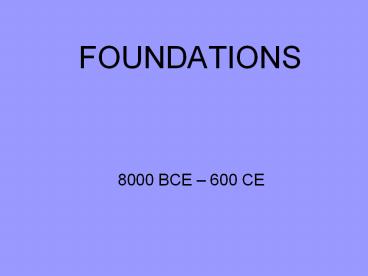FOUNDATIONS - PowerPoint PPT Presentation
1 / 11
Title:
FOUNDATIONS
Description:
FOUNDATIONS 8000 BCE 600 CE Locating World History in the Environment and Time Environment-interaction of geography and climate with the development of societies ... – PowerPoint PPT presentation
Number of Views:55
Avg rating:3.0/5.0
Title: FOUNDATIONS
1
FOUNDATIONS
- 8000 BCE 600 CE
2
Locating World History in the Environment and Time
- Environment-interaction of geography and climate
with the development of societies - River Valley Chart
- Importance (Nature) of Neolithic Revolution Notes
- Climate change, domestication of plants and
animals - Economic and Social results of Neolithic Rev
- Major population changes resulting from human and
environmental factors
3
Developing Agriculture and Technology
- Agricultural, pastoral and foraging societies and
their demographic characteristics - Africa, America, South East Asia Examples
- Nomad and Pastoralist Notes
- Africa Bantu
- America
- Emergence of Ag and Tech change (tools)
- Nature of Village society vs. Complex Societies
- Catal Huyuk and Jericho (lack political
organization, size) - Key stages of Metal Use Bronze Mesopotamia and
Indus Iron Hittites and Bantu (tools and
weapons) - Compare societies and cultures that include
cities with pastoral and nomadic societies.
(River valleys compared to Indo-Europeans or
Bantu)
4
Demographic Changes Due to Environmental Factors
- Complex societies
- Bantu, Indo-Europeans, Huns, Goths
- Disease
- Time
- Changes
- Neolithic Revolution domestication, farm tools,
ore - Collapse of Societies
- Continuities
- Migration, war, trade
5
Characteristics of Civilization
- River Valley Chart (Mesopotamia, Egypt, Indus,
Shang) - Compare the Caste system to other systems of
social inequality devised by early and classical
civilizations including slavery (Confucianism) - Compare the political and social structures of
two early civilizations, using any two of the
following Mesopotamia, Egypt, Indus Valley,
Shang dynasty, and Mesoamerica and Andean South
America - Nature of Patriarchal Systems
6
Classical Civilizations
- SPECS plus Greece (Snapshot)
- Major Political Developments in China, India and
the Mediterranean. (Mandate of Heaven, Hindu and
Buddhist kingdoms unite India, Oligarchy,
democracy, republic, tyranny) - Political Heritage of Classical China Emperor
and Bureaucracy - Compare the development of traditions and
institutions in major civilizations like India,
China and Greece. (based on religion, philosophy,
isolation, democracy and population) - Social and Gender Structures
- Major trade patterns (Mental Map)
- Art, Science and Technology (Greco-Roman art,
Indian science, Chinese technology) - Greek approach to science and Philosophy,
Aristotle but no other philosophers.
7
Major Belief Systems
- Basic features of belief systems (Religion Chart)
- Polytheism Hellenic/Hellenistic/America/Africa
- Hinduism
- Judaism
- Confucianism
- Daoism
- Buddhism
- Christianity
- Major Comparison Compare the major religious and
philosophical systems including similarities in
cementing social hierarchy, e.g. Hinduism
contrasted with Confucianism. - Role of women in different belief systems
(convents) - Buddhism, Christianity, Hinduism, Confucianism
8
Late Classical Period (200-600 c.e)
- Understand how and why the collapse of empire was
more sever in western Europe than it was in the
eastern Mediterranean or in China - Movement of People
- Huns and Germans
- Interregional Networks, trade and religion
- Zoroastrians, Manichaeism, spread of religions
(see power point) - Diffusion of Religions, but not specific forms.
- Describe interregional trading systems like the
Indian Ocean trade (Major Comparison)
9
Diverse Interpretations
- Issues involved in using Civilization (See
Sterns reprint) - What is the most common source of change
connection or diffusion vs. independent
invention? - Mental map
10
REMEMBER!
- The exchange of goods ideas shaped this period
and led to further change throughout the world
Silk Road, Indian Ocean, Mediterranean Sea - Discovery of agriculture changes lives at a rapid
pace - Emergence of gender roles reinforced by
government religion
11
- Major world religions emerged influenced large
numbers of people (Hinduism Buddhism,
Confucianism, Daoism in Asia Christianity
Judaism in Europe and Asia) - Emerging civilizations grew into larger and more
complicated organizations such as empires Rome,
Han, Gupta































